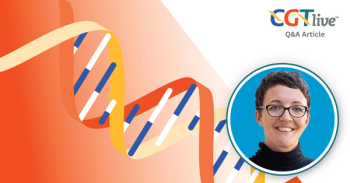
Improving Cell Therapy Manufacturing Through Strategic Partnerships
Paul Lammers, MD, MSc, president and chief executive officer, Triumvira Immunologics, discussed the challenges of manufacturing cell therapies.
Triumvira Immunologics is developing next-generation chimeric antigen receptor (CAR) T-cells with their T-cell antigen coupler (TAC) technology. TAC technology activates T-cell receptors (TCRs) through more natural pathways than traditional
The company’s lead programs are TAC-01 HER 2, an autologous cell therapy, and TAC-02 HER2, an allogeneic cell therapy. Triumvira initiated a phase 1/2 trial (NCT04727151) of TAC-01 HER 2 in April 2021 and TAC-02 HER2 is in investigational new drug (IND)-enabling studies. A BCMA-targeted therapy for multiple myeloma is also in IND-enabling studies.
GeneTherapyLive spoke with Paul Lammers, MD, MSc, president and chief executive officer, Triumvira Immunologics, to learn more about their techniques in cell manufacturing and their recent partnership with Lonza.
GeneTherapyLive: Is Triumvira focusing more on allogeneic or autologous cell therapies, and why?
Paul Lammers, MD, MSc: That's important because there are 2 different types of cell sources that you can use for cell therapy: the patient's own cells, that is autologous cells, or cells from a healthy donor, that is, allogeneic. Now, allogeneic is very appealing, because the cells are from a healthy donor, the time to manufacture is shorter, and therefore the patient gets the treatment faster. However, allogeneic is not without risk, because of graft-versus-host disease, that is a very serious complication of allogeneic therapies. Triumvira feels very strongly that we need to develop both platforms, autologous as well as allogeneic.
How is Triumvira approaching cell manufacturing?
So, the big news is that on the autologous cell therapy front, we are truly at the forefront of innovation with a deal that we did with Lonza, which is 1 of the 2 biggest T-cell manufacturers in the world, for the use of their Cocoon platform, which is an all-in-1 system. It's closed, automated, easily scalable, you don't need a massive footprint or have to build a manufacturing facility for it, and it produces fantastic TAC T-cells, quality-wise. When we announced our deal with Lonza in the middle of last year, it was shortly after Stanford University, the Sean Parker Institute, and Fred Hutchinson Cancer Research Center in Seattle also announced similar deals with Lonza for the use of Cocoon. And, in fact, we will be the first US biotech to dose patients with T cells made in a Cocoon system. So that's on the autologous side.
The biggest problem that major pharma companies had getting into cell manufacturing in the first place was that they were concerned that they had to build these massive factories to deal with the industry side. The normal way of creating cells is still very difficult, it takes up a lot of space and is very resource intensive. Since you still have to move the cells from one bank to another, you have to add cytokines and different medias, all of that takes time and effort, and it's prone to operator error.
By now putting everything in a cocoon, it's an automated system. You put the blood from the patient in, you close it, it’s like the size of a microwave. It’s in a cassette that you put into the machine, you close the machine, the cell is transfected. So activation of the cell transfection of the cell. With that, we bring the TAC structure into the T cells to a lentivirus. We genetically engineer the cells then expand them into billions and billions of cells. Then you harvest, freeze, and ship the cells to a clinic and eventually to a patient.
So, you can hang 6 or 8 of these cocoons on “trees” that revolve. That means you can build a sizable commercial manufacturing facility without needing a massive footprint. That’s another huge benefit, we think. It’s closed, automated, cheaper to make, and reduces your footprint as well. Ultimately, in the future, it could be a point-of-care system in which we could bring cell therapy to the community oncology setting. The patient comes in, gives his blood, the blood goes into the cocoon, the patient comes back 21 days later and gets the cells back. You wouldn’t have to go to a high-level academic center and travel all over the country to get there. That is ultimately the future of the cocoon, and that's what we would love to get to. We need to expand cell therapy to the masses because there are so many eligible cancer patients that would love to receive this, but they're just too far away from the centers to do it.
Tell me more about your partnership with Lonza.
The reason that Lonza wanted to work with us is because they wanted to take us to a worldwide manufacturing level. Lonza wanted to work with Donna Rill, our chief technology officer, who is a recognized key opinion leader in the world of T cell manufacturing and process development. She's been doing it for 30 years. So, Lonza wanted to work with Donna to optimize the use of Cocoon.
So, we set up a research collaboration manufacturing agreement with them. We have the cocoons up in Centre of Excellence for Cell Therapy in Montreal, a beautiful GMP facility where they actually make the TAC T-cells for us. But we also have 1 cocoon at our own process development lab so we're working with the development team at Lonza to further optimize the use of the tool. That can only improve our speed and output.
At the end of the day, there are 3 important things for autologous manufacturing: we need to improve the quality of the cells, the quantity of the cells, and reduce the cost. Those are the most important things because, again, these are such expensive therapies. If you think about Kymriah, that's about $75,000. If cell therapies break through into solid tumors, costs will have to come down because the incidence of solid tumors is so much higher than the incidence of liquid tumors. So, that is all part of the process that we keep improving. Any day that we can shave off is a day gained for the patient – every day we can reduce the process by is a day faster that the patients get their cells back. That’s what we’re focusing on right now.
Transcript edited for clarity.
Newsletter
Stay at the forefront of cutting-edge science with CGT—your direct line to expert insights, breakthrough data, and real-time coverage of the latest advancements in cell and gene therapy.































